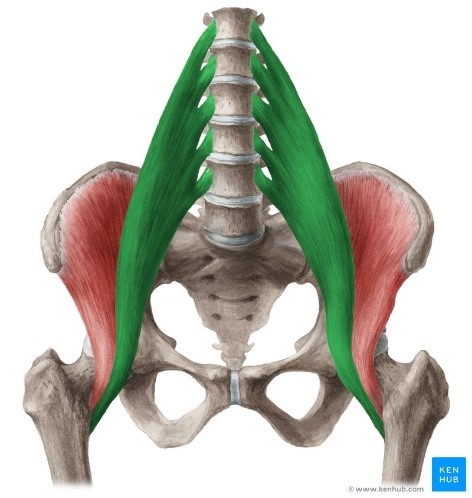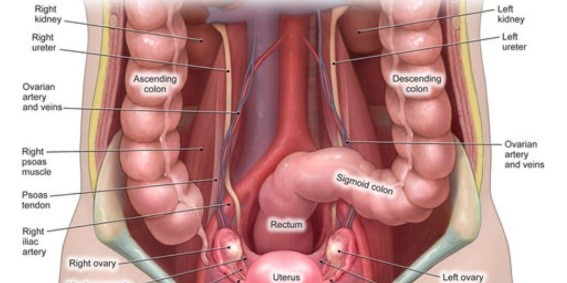Psoas – Is it really the cause of global warming?

I’m sure many of you have clients who come in telling you that their psoas muscles are tight and the source or all pain and misery in their lives. I know for many years I followed the pack and current thinking that psoas was a problem child that was typically short and tight, contributed to an anterior tilt of the pelvis, and needed to be stretched to restore its optimal function. Psoas was and still is sited as the major dysfunctional player in hip and back pain. I used to regularly stretch and get massage to release my evil psoas. I still wince when I recall those massages. Getting massage work on your psoas is like medieval torture. Just awful. Just because it hurts – it doesn’t mean it’s good for you. There was a disturbing trend around 2015 (which thankfully seems to have disappeared) where trainers were standing on their client’s bellies to try and release psoas. This is a bad idea and makes me pull funny faces so I won’t write any more about this.
In 2008 I was lucky to work with a very clever UK (now New Zealand based) physiotherapist called Jacqui Clark who changed my thinking about how this muscle works. Psoas is a complex muscle with a number of roles. Let’s meet your psoas.
You may have noted that the name iliopsoas isn’t used that often anymore. That makes a lot of sense. Iliacus (the ilio part of iliopsoas) is so different to psoas that it doesn’t make sense to put them together in a name. It’s like pairing the deltoid and quadriceps to make a delticeps – or would that be a quadroid.
Iliacus has different muscle architecture, a different nerve supply and totally different roles to psoas. I’m also not going to call it psoas major. Yeah there is a psoas minor, but a lot of people don’t have one of these so I’m going to ignore it.
 Psoas is a big thick muscle. If you were to take a cross section through the lower lumbar spine, psoas would be the thickest muscle in that cross section. This should give some insight on just how important this muscle is. It hugs the lumbar spine attaching to all the transverse processes, vertebral bodies and intervertebral discs apart from L5/S1. Psoas sweeps around the anterior surface of the ilia and all the parts of psoas form a common tendon which descends and shares a common insertion with the iliacus muscle on the lesser trochanter of the femur. Now that’s a pretty muscle with its fascicles and sweeping curves – whit woo!
Psoas is a big thick muscle. If you were to take a cross section through the lower lumbar spine, psoas would be the thickest muscle in that cross section. This should give some insight on just how important this muscle is. It hugs the lumbar spine attaching to all the transverse processes, vertebral bodies and intervertebral discs apart from L5/S1. Psoas sweeps around the anterior surface of the ilia and all the parts of psoas form a common tendon which descends and shares a common insertion with the iliacus muscle on the lesser trochanter of the femur. Now that’s a pretty muscle with its fascicles and sweeping curves – whit woo!
But wait there’s more. Anatomy has expanded over the years to show us about fascial connections, and psoas is VERY connected. The medial arcuate ligament is a continuation of the superior psoas fascia that continues up to connect with the diaphragm. As the psoas descends, its fascia becomes thick and is continuous with the pelvic floor fascia. This also forms a link with transverse abdominus, and the internal oblique. Psoas is definitely connected to the inner unit muscles that are essential for pelvic and spinal control.
The best-known role of psoas is as a hip flexor. It can also extend, flex, and laterally flex the lumbar spine a small amount since the origins hug the spine. Sure it does all that, but it does a lot more too. Psoas is well placed to help control the segments of the spine. Since psoas has segments – different parts can help control individual segments. Back pain researchers have shown that when you get pain at a segment, for example at L4/L5, then psoas is inhibited at this level too and can atrophy if pain has been present for some time. Psoas helps to control the sacroiliac joint and also helps “suck the ball of hip into the socket” to help control the hip joint. When you flex your hip, psoas stiffens up the spine and pelvis to stop them getting thrown around and damaged. Psoas actually posteriorly rotates the pelvis to help offset the pull of ilicus. It’s role in control is as important as its role in moving the hip and spine. Bottom line is that your psoas is very useful!
So if you’ve got a sore hip or lower back you gotta stretch your psoas right? – Nope. There is very little evidence that psoas is short or produces an anterior tilt to start with. Stretching inhibits muscles – see my article on stretching. Do you really want to inhibit such a cool dude of a muscle that helps control your lumbar spine, sacroiliac joint and hip? I think not.
 Psoas is also intimately linked to your viscera. If you’re only thinking muscles you’re going to come unstuck if you’re working with bodies – it’s much more than movement. Your ascending and descending colons are right in front of your psoas muscles. Your kidneys also have a close relationship with psoas. On a recent course I was on the lecturer commented that the main cause of psoas dysfunction he saw in his clients was due to colon issues.
Psoas is also intimately linked to your viscera. If you’re only thinking muscles you’re going to come unstuck if you’re working with bodies – it’s much more than movement. Your ascending and descending colons are right in front of your psoas muscles. Your kidneys also have a close relationship with psoas. On a recent course I was on the lecturer commented that the main cause of psoas dysfunction he saw in his clients was due to colon issues.
Psoas also works in conjunction with all the muscles around your pelvis and spine. While it’s a sexy muscle – it’s not the only player in the game. With dysfunction it can be worth investing in some isolation/activation exercises to get psoas working better. If you want to explore this further check out the end of this article which has some good tips on how to start working with a dysfunctional psoas.
In the meantime. Stop stretching this shit out of your psoas, look after your gut function and try some of the activation exercises in the article I referenced.
